Selling a fire-damaged home in California requires navigating strict guidelines and complex processes. Homeowners must first document damage thoroughly, including interior/exterior photos, structural notes, and repair records. Next, they should file an insurance claim, participating actively in the assessment and keeping detailed records for fair compensation. Engaging skilled professionals for assessments, repairs, and legal guidance is crucial. By following these steps and gathering solid evidence, homeowners can unlock the future potential of their California property while receiving a fair settlement.
In the aftermath of a fire, navigating the complex process of filing an insurance claim can be daunting. This comprehensive guide is tailored for California homeowners facing the challenge of selling a fire-damaged property. We demystify every step from understanding fire damage assessment to maximizing compensation and post-claim actions. Armed with essential knowledge on documenting losses, overcoming challenges, and effective negotiation strategies, you’ll be better equipped to navigate this crucial period and rebuild your home.
- Understanding Fire Damage Assessment in California
- The Fire Insurance Claim Process Step-by-Step
- Documenting and Proving Your Loss: Essential Evidence
- Common Challenges When Selling a Fire-Damaged Property
- Maximizing Compensation: Tips for Effective Negotiation
- Rebuilding and Restoring: Post-Claim Actions for Homeowners
Understanding Fire Damage Assessment in California

In California, fire damage assessment plays a pivotal role in the process of selling a fire-damaged home. The state has strict guidelines and protocols for evaluating such properties to ensure fairness for both homeowners and insurance companies. This assessment goes beyond mere visual inspection; it involves a comprehensive analysis that considers various factors, including structural integrity, extent of burn, and potential hazards. Professionals skilled in this domain employ advanced techniques and tools to determine the scope of repairs needed, which is crucial for settling fire insurance claims effectively.
Understanding the intricate aspects of fire damage assessment is essential for homeowners looking to sell their affected properties. How to sell a fire damaged home in California involves a strategic approach where accurate information and transparent communication are key. Homeowners should engage professionals who can navigate the complex process, ensuring they receive fair compensation while meeting insurance company requirements. This knowledge empowers them to make informed decisions, ultimately facilitating a smoother transition during the sale of their fire-damaged residences.
The Fire Insurance Claim Process Step-by-Step

After a fire, navigating the insurance claim process can seem daunting. However, understanding each step can help streamline the recovery process and ensure you get the compensation you deserve for your California fire-damaged home. Here’s a simplified guide on how to sell a fire damaged home in California:
1. Notify Your Insurance Company: Contact your insurer as soon as possible after the fire. They will provide guidance, document any initial damages, and assign an adjuster to assess your claim. Be sure to keep detailed records of all communications and documents related to the incident.
2. Document the Damage: Take extensive photos and videos of both the exterior and interior of your home. Document every affected area, noting smoke and water damage, charred surfaces, and any structural issues. Keep these records organized for submission with your claim. You should also create an inventory of personal belongings damaged or lost in the fire, complete with descriptions and estimated values.
Documenting and Proving Your Loss: Essential Evidence

When it comes to fire insurance claims in California, documenting and proving your loss is a critical step in the process of selling a fire-damaged home. It’s essential to gather comprehensive evidence that showcases the extent of the damage caused by the fire. This includes taking detailed photos of both the interior and exterior of the property, noting any structural damage, and keeping records of all repairs or replacements made. A well-documented claim helps insurance adjusters accurately assess the value of your loss.
In addition to visual evidence, it’s crucial to maintain a thorough record of receipts and invoices related to temporary housing, living expenses, and any other out-of-pocket costs incurred during the recovery process. These documents not only support your financial losses but also demonstrate the disruption caused by the fire. By providing solid evidence, you can enhance your chances of receiving a fair settlement, making it easier to navigate the claims process and eventually sell your fire-damaged home in California.
Common Challenges When Selling a Fire-Damaged Property

Selling a fire-damaged property in California can be a challenging process, often fraught with unique obstacles. One of the primary hurdles is addressing the psychological impact on potential buyers; the sight of smoke damage and charred remnants might deter many from envisioning the home’s future potential. This perception is a common challenge, but it’s essential to understand that fire-damaged properties can be revitalized and transformed into desirable living spaces.
The insurance claim process itself can add complexity, with negotiations over compensation and repairs leading to delays. Homeowners may face difficulties in securing fair settlements, especially if the damage is extensive or there are disputes over restoration methods. Moreover, navigating the legalities and paperwork involved in selling a fire-damaged property requires careful consideration and professional guidance to ensure compliance with California’s specific regulations.
Maximizing Compensation: Tips for Effective Negotiation

After a fire, selling your damaged home in California can be a complex process, but with effective negotiation strategies, you can maximize compensation. The first step is to thoroughly document the extent of the damage. Take detailed photos and videos of every affected area, keeping records of all repairs and restoration estimates. This visual evidence will strengthen your claim and help justify higher compensation.
Next, understand the insurance appraiser’s role and be prepared for their inspection. Know that they may have different criteria for assessing damage, so communicate clearly about repairs already completed or planned. Be open to discussing alternative solutions, as insurers often prefer efficient, cost-effective repairs. Finally, don’t be afraid to negotiate. Present your research and evidence convincingly, highlighting market values of similar properties in California to sell damaged homes. A professional approach with well-supported arguments can lead to a fairer settlement.
Rebuilding and Restoring: Post-Claim Actions for Homeowners

After a fire damages your California home, rebuilding and restoring it is a crucial step in recovering from this traumatic event. The process begins with filing a fire insurance claim, which provides financial support to cover the costs of repairs or even a complete rebuild. Your insurance company will assess the damage and provide an estimate for the work required, ensuring that all necessary repairs meet safety standards.
Homeowners should actively participate in this phase by keeping detailed records of expenses, collecting receipts, and staying in regular communication with their insurer. It’s important to understand the scope of coverage offered by your policy and ask questions if there are any uncertainties. This proactive approach will streamline the claims process and help you make informed decisions when it comes to how to sell a fire-damaged home in California, ensuring that you receive fair compensation for your efforts in rebuilding and restoring your property.
Navigating the aftermath of a fire can be daunting, but understanding the fire insurance claim process in California is key. From assessing damage to documenting losses and negotiating compensation, this guide equips homeowners with the knowledge to successfully manage their claims. While selling a fire-damaged property presents challenges, following effective post-claim actions ensures a smoother transition towards rebuilding and restoration. Remember that, with the right approach, maximizing compensation and restoring your home are within reach.






